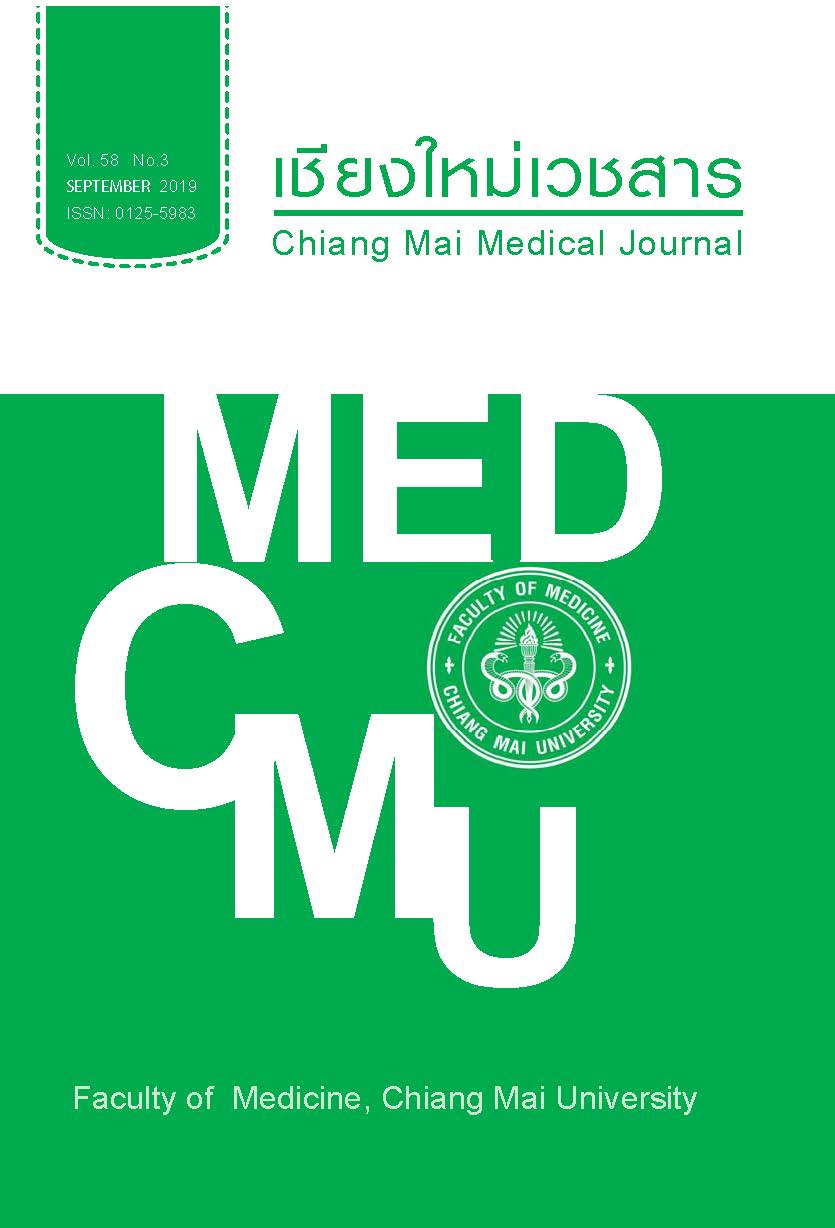Predicting factors of readiness for hospital discharge among hospitalized coronary heart disease patients at Maharaj Nakorn Chiang Mai Hospital
ปัจจัยทำนายความพร้อมในการจำหน่าย
Keywords:
readiness for hospital discharge, quality of discharge teaching, care coordination, coronary heart disease patientAbstract
Objective The purpose of this descriptive research was to identify the predicting factors of readiness for hospital discharge among hospitalized patients.
Methods The Meleis’ theory of transitions was used as a framework in this research. The sample consisted of 120 patients with coronary heart disease who were admitted to the general medical ward and critical cardiovascular medical ward of Maharaj Nakorn Chiang Mai Hospital during May – December, 2015. Research instruments included questionnaire on general information, the quality of discharge teaching scale, the care coordination scale, and the readiness for hospital discharge scale. Data was analyzed using descriptive statistics, Point biserial correlation, Spearman’s rank correlation, Pearson product moment correlation and stepwise multiple regression analysis.
Results The results revealed that quality of discharge teaching, care coordination, and being planned to admit were positively correlated with readiness for hospital discharge (r=.398, p<.01, r=.212, p<.05, r=.199, p<.05). Quality of discharge teaching was the only one predictor statistically affecting readiness for hospital discharge (p<.001), that accounted for the variance in the readiness for hospital discharge by 15.8 (R=.158, p<.001).
Conclusion The result of this research recommends that teaching method and care coordination are important factors for patients’ perception on the hospital discharge readiness. There fore, nurses should emphasize and improve the quality of discharge teaching to promote patients’readiness for hospital discharge.
References
2. ThaiNCD. Annual report 2015 [Intenet]. [cited 2016 Oct 29]. Available from: http://www.thaincd.com/document/file/download/paper-maual/Annual-report-2015.pdf. (In Thai)
3. Medical Records and Statistics Section. Annual report. Chiang Mai: Maharaj Nakorn Chiang Mai Hospital; 2008-2013. (In Thai)
4. Srikeaw U. Nursing care of coronary heart patients: continuity of care. Songkhla: Lim Brader Printing. 2000. (in Thai)
5. Sittisuk S. Guideline for ischemic heart disease 2014, The Heart Association of Thailand under the Royal Patronage [Intenet]. [cited 2016 Oct 29]. Available from: http:thaiheart.org/images/column 1291454908/Guideline%20for%20Ischemic%20Heart%20Disease%202104.pdf. (in Thai).
6. Fardy PS, Yanowitz FG. Cardiac rehabilitation, adult fitness and exercise testing. 3rd ed. Baltimore: William & Wilkins; 1995. p. 328-62.
7. Cherrington CC, Moser DK, Lennie TA, Kennedy CW. Illness representation after acute myocardial infarction: Implication on in-hospital recovery. Am J Crit Care. 2004;13;136-45.
8. Weiss ME, Piacentine LB, Lokken L, Ancona J, Archer J, Gresser S, et al. Perceived readiness for hospital discharge in adult medical-surgical patients. Clin Nurse Spec. 2007;21:31-42.
9. Sumritrin S. Self-care behaviors of myocardial infarction patient before discharge from the hospital [Thesis]. Khon Kaen: Khon Kaen University. 2005. (In Thai)
10. Suwannasri S. Self-care behaviors of myocardial infarction patients before and after discharge from the hospital to home [Thesis]. Khon Kaen: Khon Kaen University. 2005. (In Thai)
11. Nasoongchon J. Self-care behaviors of post percutaneous transluminal coronary angioplasty and stenting patients [Thesis]. Khon Kaen: Khon Kaen University. 2009. (In Thai)
12. Miller JF, Piacentine LB, Weiss ME. Coping difficulties after hospitalization. Clin Nurs Res. 2008;17:278-96.
13. Kunthakhu S, Watthanakitkrileart D, Pongthavornkamol K, Dumavibhat C. Factors influencing readiness for hospital discharge in acute myocardial infarction patients. J Nurs Sci S1. 2009;27:83-91. (In Thai)
14. Lawson K, Bloom S, Sadof M, Stille C, Perrin J. Care Coordination for Children with Special Health Care Needs: Evaluation of a State Experiment. Matern Child Health J. 2011;15:993-1000.
15. Weiss ME, Piacentine LB. Psychometric proper-ties of the readiness for hospital discharge scale. J Nurs Meas. 2006;14:163–80.
16. Meleis AI, Sawyer LM, Im EO, Hilfinger Messias DK, Schumacher K. Experiencing transitions: an emerging middle-range theory. ANS Adv Nurs Sci. 2000;23:12-28.
17. Meleis AI. Transitions theory: Middle range and situation specific theories in research and practice. New York, NY: Springer Publishing; 2010.
18. Faul F, Erdfelder E, Buchner A, Lang AG. Statistical power analyses using G*Power 3.1: tests for correlation and regression analyses. Behav Res Methods. 2009;41:1149-60.
19. Srirat C, Panuthai S. Factors related to readiness for hospital discharge among hospitalized
patients in tertiary hospitals. Rama Nurs J. 2017; 23:99-112. (In Thai)
20. Sriprasong S, Hanucharurnkul S, Panpakdee O, Krittayaphong R, Pongthavornkamol K, Vorapongsathorn T. Personal factors related to perceived readiness for hospital discharge of patients with acute myocardial infarction. Thai J Car Thor Nurs. 2011;22:44-57. (In Thai)
21. Hadjistavropoulos H, Biem H, Sharpe D, Bourgault-Fagnou M, Janzen J. Patient perceptions of hospital discharge: reliability and validity of a patient continuity of care questionnaire. Intl J Qual Health Care. 2008;20:314–23.
22. Cohen J. Statistical power analysis for the behavioral sciences. 2nd ed. Hillsdale. NJ: Lawrence Erlbaum Associates; 1998.
23. Stevens J. Applied multivariate statistics for the social sciences. 4th ed. Mahwah, New Jersey: Lawrence Erlbaum Associates; 1992.
24. Brent L, Coffey A. Patient’s perception of their readiness for discharge following hip fracture surgery. International Journal of Orthopaedic and Trauma Nursing [Internet]. 20013 [cited 2017 Oct 3]. 17:190-8. Available from: https://www.orthopaedictraumanursing.com/article/S1878-1241(13)00002-6/pdf.
25. Saengrut B, Pudwan R, Somana P, Rattanasathien R, Wongpalee T, Solai N, et al. Predicting factors of readiness for hospital discharge among hospitalized patients in medical wards. Maharaj Nakorn Chiang Mai Hospital. 2015, in press. (In Thai)
26. Poncharoen P. Factors related to discharge readiness in patients with congestive heart failure [Thesis]. Chon Buri: Burapha University. 2015. (In Thai)
27. Weiss ME, Lokken L. Predictor and outcomes of postpartum mothers ’perception of rediness for discharge after birth. J Obstet Gynecol Neonatal Nurs. 2009;38:406-417.
Downloads
Published
How to Cite
Issue
Section
License

This work is licensed under a Creative Commons Attribution-NonCommercial-NoDerivatives 4.0 International License.










